
eXtensions
Photo Mechanic: Workflow Software for the Journalist |
I was contacted by a news agency photographer who had questions about using OS X. He had moved to the Mac and not everything works as it does in Windows. During our chat, I asked him if he used Apple's Aperture or Adobe's Lightroom for workflow operations. Neither, he said, Photo Mechanic: the company insists on it.
This was a new one on me, so after ending the phone conversation I downloaded it. While the interface and some tools are not as sophisticated as Aperture, there is a lot a photographer can do. It can also upload images directly.
Photo Mechanic (I had version 4.5.1.1) is not expensive at $150 (5200 baht) which is less than Aperture or Lightroom, but it does not have all their image-manipulation tools. There are versions for Windows and OS X. A demonstration version is available for a 30-day trial period. We need to request a demo account and the passkey is sent using email. It was slightly irksome to have to enter these details every time I started it up.

While Aperture and Lightroom have a black background to all windows, Photo Mechanic first opens with a grey panel in which there are no images. That grey may be changed to any colour.
Images may be added using the navigator panel to the left and clicking on a folder. However it is also easy to change the default application in the preferences of Image Capture. In that case, Photo Mechanic will import the images into a preselected folder, using (correctly) the term, "ingest". The ingestion/import is in a new folder inside that nominated.

The main viewing windows is a resizable contact sheet. Placing the cursor over an image shows four controls: anti-clockwise, clockwise, Information and zoom. Clicking on zoom (or double clicking an image) brings up a preview window. Buttons above the contact sheet allow sorting of images in sixteen ways, as well as a customizable option.
Each image can be quickly classified in a way similar to that in other software using stars (1-5). This uses the Control key plus a number rather than the Command key. The Command key is used for a colour classification system (1-8), paradoxically with 1 being the highest. I imagine one would become familiar with either the stars or colours system. As a further indication of the flexibility of this software, those colours may be changed in Preferences.

The Preview window is much like the one in iPhoto: a main image and a roll of smaller images (in this case below). To the right is metadata, crop and zoom, and a histogram. The data displayed in Information is consideraby less than in Aperture or Lightroom but considerably more may be added using the IPTC window.
A toolbar has utilities, some of which are duplicated by keystrokes or menu items. It is possible to work rapidly in this application. Included in the tools are a variety of views for image comparison, the usual left and right arrows, rotate and delete icons, plus one marked IPTC.
This window is aimed at press photographers and allows entering of a considerable amount of data in a common format developed in the 70s by the International Press Telecommunications Council. A drawer opens for adding several more fields to the dataset.
There is a "Full" view window, and I was able to hide the Toolbar, but the image was not totally full screen, despite some stretching of the image window. This is not a major criticism, bearing in mind the target userbase.
The edit key requires that Photo Mechanic be linked to an application. Setting this up was not easy as there are so many variables within the application's preferences that I could not find it and had to ask.
The preferences themselves are split into nine sections: General, Contact Sheet, Files, RAW, Launching, IPTC/XMP, Preview, Caching and Color Management. With each of these a high degree of fine tuning is possible and once set to a photographer's requirements would not need to be changed in the future, apart from some minor adjustments. Watermarking is effected while using the Save As menu and this accepts Thai script.
Press photographers need images to be sent to news sources and there are several methods of using the Internet to transmit work in addition to "export" and "burn". Like other applications it sends files (in a number of sizes) to email via a user's default application. FTP may also be selected once settings have been entered.
An additional feature (also in Aperture) allows an image to be sent directly to a user's account in Photoshelter, a website for distribution of images by professionals.
Although intended for the specfic market of photojournalism, Photo Mechanic may be a viable alternative to other workflow software that currently exists.

For further information, e-mail to
Back to
eXtensions
To
eXtensions: 2004-05
To
eXtensions: Year Two
To
eXtensions: Year One
To
eXtensions: Book Reviews
Back to homepage